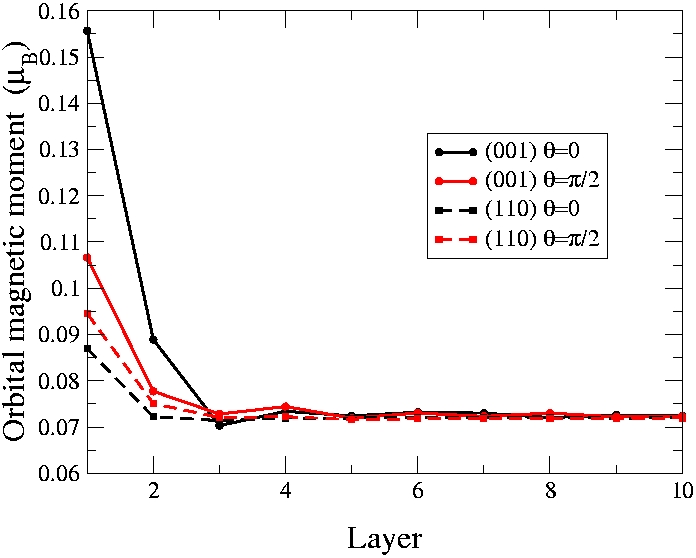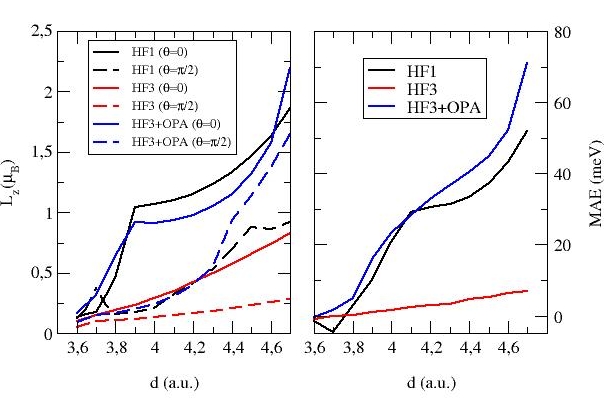G. Autès, C. Barreteau, D. Spanjaard, M.C. Desjonquères
The magnetic properties (spin and orbital magnetic moments, magneto-crystalline anisotropy energy (MAE)) of nanoparticles, thin films and wires have recently attracted a lot of attention due to their potential applications mainly in the Information Technology sector.
We have carried out a systematic study of the magnetic properties of iron in the tight-binding approximation including s, p, and d valence atomic orbitals taking into account spin polarisation using a Stoner-like model and in the presence of spin-orbit coupling[1]. The validity of the model has first been established by studying in details the magnetic properties of the bcc and fcc bulk phases and comparing the results to those of ab-initio calculations using the PWscf code. This model has then been applied to investigate the (110) and (001) bcc surfaces. The corresponding electronic structures and magnetic moments are very similar to those obtained from ab-initio codes. In addition we have studied the variation of the component of the orbital magnetic moment on the spin quantisation axis as a function of depth, revealing a significant enhancement in the first two layers, especially for the (001) surface (see Fig.1).

Finally the one dimensional system of a monatomic Fe wire has been investigated in details. After having checked that the bulk Stoner parameter has not to be changed in order to reproduce the variation of the spin magnetic moment as a function of the inter-atomic distance and the electronic band structure given by PWscf calculations, we have determined the orbital contribution to the magnetic moment and the MAE. At the equilibrium inter-atomic distance the MAE reaches several meV and the orbital moment is highly anisotropic (0.4 and 0.2mB per atom for magnetisations parallel and perpendicular to the wire, respectively). These two quantities are thus much larger than in the bulk in which it is well known that the MAE is of the order of 10-3meV and the orbital moment nearly quenched. It is interesting to note that at the equilibrium distance the easy axis is along the wire but switches to the perpendicular direction under compression (Fig. 2).

However experiments suggest that in one dimensional systems the orbital moment may reach about 1mB. It is known that the Stoner model underestimates the orbital moment. This is the reason why an ad hoc orbital polarization ansatz (OPA) has often been introduced as an additional term in the Hamiltonian [2]. A more rigorous way of obtaining both the spin and orbital moments is to take into account all intra-atomic terms (determined by the three Racah parameters relative to d orbitals) of the Coulomb interactions, the latter being treated in the Hartree-Fock approximation[3]. With this model we have found that the orbital moment and the MAE are strongly enhanced (Fig.3) whereas the OPA accounts only qualitatively for this effect when the spin moment is saturated, but is inadequate otherwise.

REFERENCES:
[1] G. Autès, C. Barreteau, D. Spanjaard, M.C. Desjonquères, J. Phys :Condens.Matter 18, 6785 (2006)
[2] O. Eriksson, M.S.S Brooks and B. Johansson, Phys. Rev. B 41, 9087 (1990).
[3] M.C. Desjonquères, C. Barreteau, G. Autès, D. Spanjaard. Eur. Phys. Journ. B 55, 23 (2007).


